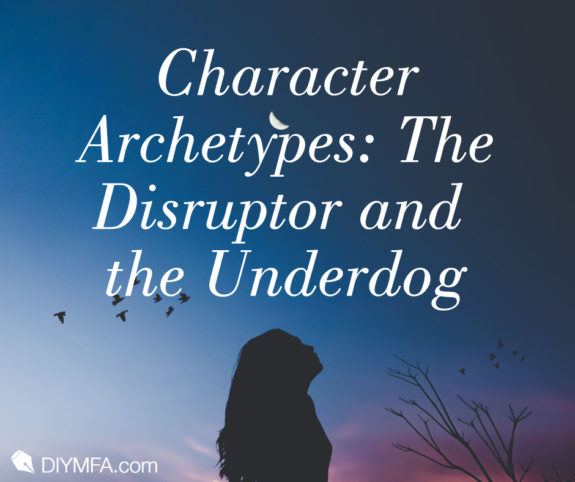Hey word nerds! We’re continuing my series on your storytelling superpower today by digging into the first two of four character archetypes. But first a quick recap: In my first post, we talked about how character, more than plot, world or any other story element, drives a story forward. If your reader doesn’t care about your protagonist, the best plot ever will still fall flat. But how do you create a character your readers want to follow? Create a character you care about.
Characters typically fall into one of four archetypes. And writers usually gravitate toward one of them. I’m my second post, we discussed the secret to creating an irresistible protagonist — leaning in to one of the four character archetypes, the one that’s right for you. But how do you determine which archetype is the one? Let’s start by taking a look at the first two: the Underdog and the Disruptor.
The Underdog
The quintessential underdog is a relatable character with a deep desire to change something in themselves or in the world around them. From Katniss Everdeen in Suzanne Collins’ The Hunger Games to Marty McFly in the Back to the Future series, underdogs are regular people caught in extraordinary circumstances but who manage to rise to the occasion and do something heroic. Underdogs have a lot of pluck and determination and they not afraid to do whatever it takes in order reach their goals. On the other hand, these characters may sometimes feel like they have something to prove so they pick battles they cannot win. And while their “bring it on” attitude might be inspiring and may get them through challenging circumstances, underdogs don’t do well in situations that demand retreat.
In terms of reader engagement, this archetype is one of the most compelling because people love rooting for underdogs. When readers see an underdog come out on top, it makes them think: “If he can do it, maybe I can, too.” But if taken too far, the underdog can seem self-righteous, like they have a chip on their shoulder. And when underdogs stubbornly make bad choices or pick the wrong battles again and again, readers may stop feeling sympathy for the character.
Signature underdog stories include rags-to-riches narratives, epic David-and-Goliath-style battles, and classic “comebacks” where a character who used to be on top needs earn back his former glory. Because the underdog is so relatable and these stories often have such high stakes, underdogs are compelling characters that readers can’t help but love.
This is one of the most prevalent archetypes in short fiction, in part because the smaller scope favors everyman characters over their larger-than-life counterparts. Also the more condensed word count short stories, often means that it is easier to convey that character’s transformation if the protagonist is already seeking out change in the first place. To see the underdog in action, look at Mrs. Mallard in Kate Chopin’s “The Story of an Hour,” the nameless narrator in “The Yellow Wallpaper” by Charlotte Perkins Gilman, or for a more contemporary example look at the protagonist Pinky in Claire Davis’ story “Labors of the Heart.”
The Disruptor
Disruptors are larger-than-life characters who rebel against the status quo. They will do whatever it takes to change their societies, overcome all odds, and defeat tyranny. Elizabeth Bennet in Pride and Prejudice by Jane Austen, to the title character in F. Scott Fitzgerald’s The Great Gatsby, or Tris Prior in Veronica Roth’s Divergent series, disruptors take on many different forms. They are charismatic leaders who know how to persuade and inspire the people around them, though they sometimes so much on their “mission” that they wind up hurting the people around them. And, like underdogs, disruptors may focus too much on instigating change so that even with all their larger-than-life qualities, they sometimes pick fights they cannot win.
This archetype is especially powerful if you want to infuse your writing with a broader message. Because disruptors a strong vision, they can serve as vessel for you to communicate your own opinions or ideals from behind the scenes. The danger is that if you make the allegory or satire too heavy-handed, you may end up sounding preachy and alienating your readers. Also, with all that passion and charisma also comes narcissism and lack of empathy. Disruptors don’t always play well with others and there is a fine line between rebel and bully. To make your disruptor a sympathetic or even likeable character, you need to make her motivations clear to your readers and show some vulnerability in this larger-than-life character.
This may be the reason why disruptors are far less common in short stories than in book-length literature. It takes time to tease out a character’s motivations and show her vulnerability. Short fiction may not give you the necessary space to give your disruptor the depth she needs to engage your readers. This is where supporting characters can be useful in making a disruptor protagonist seem less bad by comparison. For instance, in Flannery O’Connor’s “A Good Man is Hard to Find” the grandmother is clearly unlikeable—at the beginning of the story, it is hard for readers to sympathize with her. But when Misfit holds the family captive and begins killing people, suddenly the grandmother doesn’t seem quite as terrible and we almost feel sorry for her. Similarly, Neddy Merrill in “The Swimmer” by John Cheever is a vapid, entitled snob, but as we see his life slowly deteriorate, we can’t help but feel compassion for him.







